Just head this on the radio and looked it up.
They don’t want to be eaten.
They don’t want to be sacrificed.
They don’t want to be shot for their celestial light
and lose their teeth and eyes.

The scarlet macaws want their red back, not puce or pink but rich rubescence. They squawk and screech and growl for the people to give it back.
Just head this on the radio and looked it up.
They don’t want to be eaten.
They don’t want to be sacrificed.
They don’t want to be shot for their celestial light
and lose their teeth and eyes.
#tdc3186 #ds106 my Milestone poem is For the Children by Gary Snyder
stay together
learn the flowers
go light
In this film, writer Kate Clanchy uses Edip Cansever's poem 'The Table', translated by Richard Tillinghast, to inspire pupils to create their own poems. The activity works well with both native speakers of English and pupils who have recently learnt English.
Listened to @KateClanchy1‘s Poetry activities for schools: The Table by Edip Cansever ripped from YouTube. Which is great. Kate Clanchy uses poem ‘The Table’ to inspire pupils to create their own poems. Loved the poem and read to my class this morning.
I have been working for years. on a four-line poem. about the life of a leaf; I think it might come out right this winter
Book Title Poetry pic.twitter.com/HRchdqOV3Z
— Kenny Pieper (@kennypieper) May 9, 2020
Very cool indeed Kenny, I’ve done spine stories: photo of a pile of books with my class, & I think #ds106
you might like:
RFID Machines in British Libraries Are Producing Charming Found Poetry
Which is pretty wonderful and I saw in @katexic newsletter
“|n|otabilia 738 ⁂ "Poem" ⁂ A.R. Ammons || From *Notabilia*, a daily(ish) newsletter → https://t.co/sx3TZ42SCe #notabilia #quotes #newsletter #literaryquotes #commonplacebook #ARAmmons #poem #NaPoMo #NaPoMo20”
I don’t think I’ve tweeted how much I value and enjoy @Notabilia in my email inbox
|n|otabilia 738 ⁂ "Poem" ⁂ A.R. Ammons || From *Notabilia*, a daily(ish) newsletter → https://t.co/sx3TZ42SCe
#notabilia #quotes #newsletter #literaryquotes #commonplacebook #ARAmmons #poem #NaPoMo #NaPoMo20 pic.twitter.com/zrChSfJfdx
— Notabilia (@notabilia) April 1, 2020
Hi Kevin,
I love the random so love this idea.You mentions a couple of my toys/tools along side some others.
The Random Flickr blendr was originally thought of as a sort of contemplation toy, so I avoided making it easy to grab images. I guess I could make that easier now there seems to be a purpose. I think FlickrCC Stampr used to have a url parameter to kick off a search I’ll look at adding that back in at times.
Side note, I remember Ben Rimes Poetry for People blog. Now gone but discussed here: Come Write Poetry With Me This April! – The Tech Savvy Educator
Update, 1-April-19 : I’ve made a couple of changes that might be useful:
http://johnjohnston.info/fcc/?s=poem adding ?s=searchword will preload the flickr search
On Random Flickr Blendr I’ve added a pause button and move the links for better screenshotting. I changed the links to flickr shortlinks so they can be read from an image (Not very accessible!)
Thanks for the link to Reading a Poem: 20 Strategies. A good one.
via @katexic newsletter! I am sure we have made book spine poems in DS106 and I’ve made them with my class, but I do like a bit of serendipitous automation.
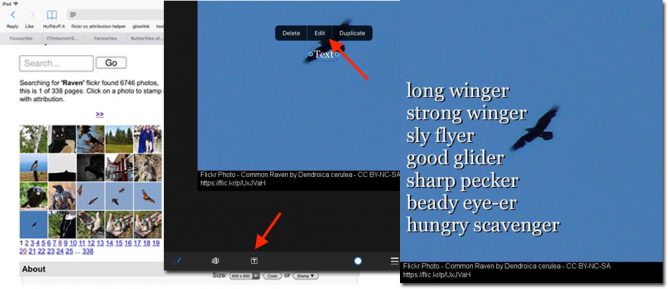
This is pretty basic stuff but I’ve found it useful in class.
I’ve often combined writing poetry with digital tools in the classroom. There are a lot of short forms that mean even the slowest typist can produce something good in limited time. From a pupil blogging perspective pupils of varying ability often get great results they can be proud of publishing.
When I started using iPads in teachers training and with pupils, I started using simple poetry forms as a way to produce something quickly that could develop from text be combined with images, video and audio.
Good, IMO, forms are kennings, lunes, haiku and six word stories.
Back then we used skitch and comic life to added text to pictures. More recently I moved on to the free version of pic collage 1.
When I arrived back in the classroom with a pile of iPads I’ve been using the technique quite a bit.
More recently 2 I’ve cut out third party apps to use the newish built in markup in the Photos app. Recently I demoed the process at an interview and saw Jenni Robertson show it at an Apple event in Glasgow. On both occasions I was surprised to find that it was a new concept to most of the audience. I though it might be worth a post here. There is a video embedded at the bottom of this post, but here are some written instructions.
This is a good opportunity to talk and demo a wee bit about copyright and attribution. In class we often use the Morguefile or my own FlickrCC Stampr.
I believe it is best to use the notes app for this, avoiding thinking about how the text looks, where it goes etc.
Copy the text to the clipboard.
Open photos
Select and view the image.
Click on the adjustment icon
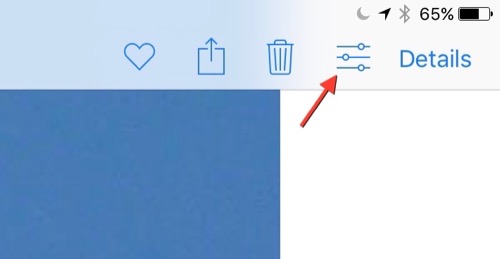
When the photo opens click on the ellipses and then Markup
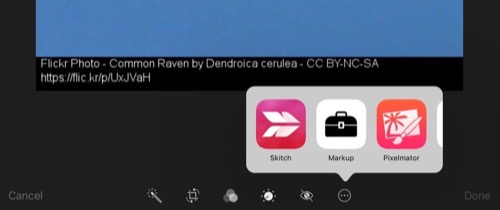
On the markup screen click the T tool to add a text box and then press on the box to edit it.
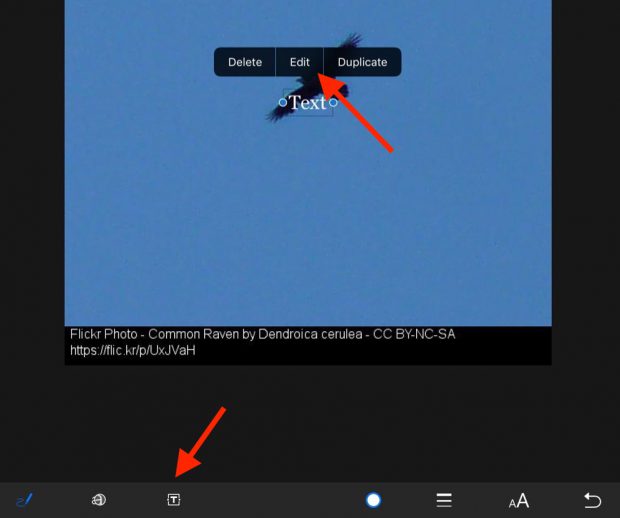
Paste in your poem.
Adjust the size, colour and placing of the text.
Duplicate the text, change the colour of one and move the top one over the bottom leaving a nice ‘old style’ drop shadow. I think this is worth it as a intro to layers in graphics. It can also hep readability on complex backgrounds.
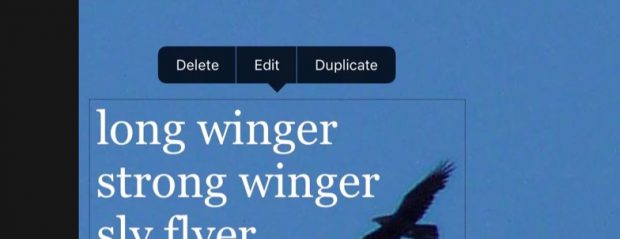
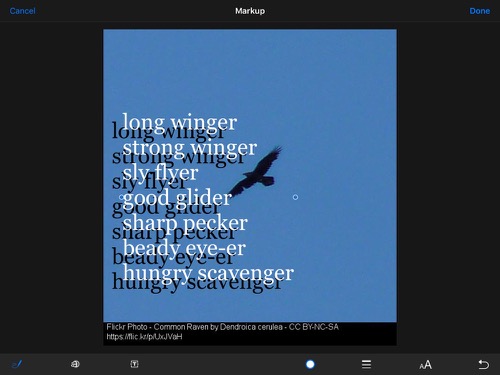
Although this is a very simple lesson I think it give the opportunity to teach a few different things over and above literacy involved in the writing:
It has the potential for being extended into video & audio editing (groups pictures perhaps) and sharing the results.
Here is a quick screencast.
1. Some examples from my class using pic collage Frosty Photos and Poems – Banton Biggies ↩
2. For example Kennings, we know about animals – Banton Biggies ↩